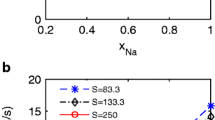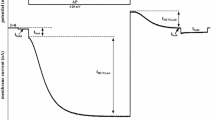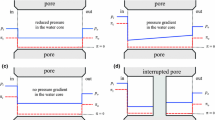Abstract
In hypertonic solutions made by adding nonelectrolytes, K+ channels of squid giant axons opened at usual asymmetrical K+ concentrations in two different time courses; an initial instantaneous activation (I IN) and a sigmoidal activation typical of a delayed rectifier K+ channel (I D). The current–voltage relation curve for I IN was fitted well with Goldman equation described with a periaxonal K+ concentration at the membrane potential above −10 mV. Using the activation–voltage curve obtained from tail currents, K+ channels for I IN are confirmed to activate at the membrane potential that is lower by 50 mV than those for I D. Both I IN and I D closed similarly at the holding potential below −100 mV. The logarithm of I IN/I D was linearly related with the osmolarity for various nonelectrolytes. Solute inaccessible volumes obtained from the slope increased with the nonelectrolyte size from 15 to 85 water molecules. K+ channels representing I D were blocked by open channel blocker tetra-butyl ammonium (TBA) more efficiently than in the absence of I IN, which was explained by the mechanism that K+ channels for I D were first converted to those for I IN by the osmotic pressure and then blocked. So K+ channels for I IN were suggested to be derived from the delayed rectifier K+ channels. Therefore, the osmotic pressure is suggested to exert delayed-rectifier K+ channels to open in shrinking rather hydrophilic flexible parts outside the pore than the pore itself, which is compatible with the recent structure of open K+ channel pore.












Similar content being viewed by others
References
Armstrong CM, Hille B (1998) Voltage-gated ion channels and electrical excitability. Neuron 20:371–380
Clay JR (1991) A paradox concerning ion permeation of the delayed rectifier potassium ion channel in squid giant axons. J Physiol 444:499–511
Clay JR (2000) Determining K+ channel activation curves from K+ channel currents. Eur Biophys J 29:555–557
Clay JR, Kuzirian AM (2000) Localization of voltage-gated K+ channels in squid giant axons. J Neurobiol 45:172–184
Conti F, Inoue I, Kukita F, Stühmer W (1984) Pressure dependence of sodium gating currents in the squid giant axon. Eur Biophys J 11:137–147
Cuello LG, Jogini V, Cortes DM, Perozo E (2010) Structural mechanism of C-type inactivation in K+ channels. Nature 466:203–208
Doyle DA, Cabral JM, Pfuetzner RA, Kuo A, Gulbis JM, Cohen SL, Chait BT, MacKinnon R (1998) The structure of the potassium channel: molecular basis of K+ conductance and selectivity. Science 280:69–77
French RJ, Shoukimas JJ (1981) Blockage of squid axon potassium conductance by internal tetra-N-alkylammonium ions of various size. Biophys J 34:271–291
Gilly WF, Armstrong CM (1982) Divalent cations and the activation kinetics of potassium channels in squid giant axons. J Gen Physiol 79:965–996
Goldstein SAN, Bockenhauer D, O’Kelly I, Zilberberg N (2008) Potassium leak channels and the KCNK family of two-P-domain subunits. Nat Rev Neurosci 2:175–184
Hamill OP (2006) Twenty odd years of stretch-sensitive channels. Pflügers Arch 453:333–351
Hammami S, Willumsen NJ, Olsen HL, Morera FJ, Lattore R, Klaerke DA (2009) Cell volume and membrane stretch independently control K+ channel activity. J Physiol 587:2225–2231
Hille B (2001) Ion channels of excitable membranes, 3rd edn. Sinauer Associates, Sunderland
Hodgkin AL, Huxley AF (1952) Current carried by sodium and potassium ions through the membrane of the giant axon of Loligo. J Physiol 116:449–472
Jiang Y, Lee A, Chen J, Ruta V, Cadene M, Chait BT, MacKinnon R (2003a) X-ray structure of a voltage-dependent K+ channel. Nature 423:33–41
Jiang Y, Ruta V, Chen J, Lee A, MacKinnon R (2003b) The principle of gating charge movement in a voltage-dependent K channel. Nature 423:42–48
Kukita F (1982) Properties of sodium and potassium channels of the squid giant axon far below 0°C. J Membr Biol 68:151–160
Kukita F (1988) Removal of periaxonal potassium accumulation in a squid giant axon by outward osmotic water flow. J Physiol 399:647–656
Kukita F (1997) Solvent-dependent rate-limiting steps in the conformational change of sodium channel gating in squid giant axons. J Physiol 498:109–133
Kukita F (2000) Solvent effects on squid sodium channels are attributable to movements of a flexible protein structure in gating currents and to hydration in a pore. J Physiol 522:357–373
Kukita F (2001) K+ channel opened by a water activity decrease. Jpn J Physiol 51:183
Kukita F, Mitaku S (1993) Kinetic analysis of the denaturation process by alcohols of sodium channels in squid giant axon. J Physiol 463:523–543
Kukita F, Yamagishi S (1976) Prolongation of the action potential of squid giant axons in viscous solutions. Proc Jpn Acad 52:323–326
Kukita F, Yamagishi S (1979) Slowing of the time course of the excitation of squid giant axons in viscous solutions. J Membr Biol 47:303–325
Kukita F, Yamagishi S (1983) Effects of outward water flow on potassium currents in a squid giant axon. J Membr Biol 75:33–44
Li W, Aldrich RW (2004) Unique inner pore properties of BK channels revealed by quaternary ammonium block. J Gen Physiol 124:43–57
Rand RP (2004) Probing the role of water in protein conformation and function. Phil Trans R Soc Lond B 359:1277–1285
Rosenthal JJC, Vickery RG, Gilly WF (1996) Molecular identification of SqKv1A. A candidate for the delayed rectifier K channel in squid giant axon. J Gen Physiol 108:207–219
Schoenmakers ThJM, Vaudry H, Cazin L (1995) Osmo- and mechanosensitivity of the transient outward K+ current in mammalian neuronal cell line. J Physiol 489:419–430
Schoppa NE, Sigwoth FJ (1998) Activation of Shaker potassium channels. I. Characterization of voltage-dependent transitions. J Gen Physiol 111:271–294
Shimizu H, Oiki S (2004) Asymmetric effect of nonelectrolytes on the gating of KcsA channel. Jpn J Physiol 54:s68
Sokolov S, Scheuer T, Cateral WA (2007) Gating pore current in an inherited ion channelopathy. Nature 446:76–78
Starace DM, Bezanilla F (2004) A proton pore in a potassium channel voltage sensor reveals a focused electric field. Nature 427:548–553
Starkus JG, Schlief T, Rayner MD, Heinemann SH (1995) Unilateral exposure of Shaker B potassium channels to hyperosmolar solutions. Biophys J 69:860–872
Tanaka T (1981) Gels. Sci Am 244:124–138
Tombola F, Pathak MM, Isacoff EY (2005) Voltage-sensing arginines in potassium channel permeate and occlude cation-selective pores. Neuron 45:379–388
Tombola F, Pathak MM, Gorostiza P, Isacoff EY (2007) The twisted ion-permeation pathway of a resting voltage-sensing domain. Nature 445:546–549
Van t’Hoff JH (1901) Osmotic pressure and chemical equilibrium. Nobel Prize Lecture in Chemistry. http://nobelprize.org/nobel_prizes/chemistry/laureates/1901/hoff-lecture.pdf
Wagoner PK, Oxford GS (1987) Cation permeation through the voltage-dependent potassium channel in the squid axon. Characteristics and mechanisms. J Gen Physiol 90:261–290
Wang S, Bondarenko VE, Qu Y, Morales MJ, Rasmusson RL, Strauss HC (2004) Activation properties of Kv4.3 channels: time, voltage and [K]O dependence. J Physiol 557:705–717
White MM, Bezanilla F (1985) Ionic and gating current studies. J Gen Physiol 85:539–554
Yahannan S, Hu Y, Zhou Y (2007) Crystallographic study of the tetrabutylammonium block to the KcsA K+ channel. J Mol Biol 366:806–814
Zagotta C, Hosni T, Deadman J, Aldrich RW (1994) Shaker potassium channel gating II: transitions in the activation pathway. J Gen Physiol 103:279–319
Zhang J, Sigworth FJ (1998) Intermediate conductances during deactivation of heteromultimeric Shaker potassium channels. J Gen Physiol 112:457–474
Zimmerberg J, Parsegian VA (1986) Polymer inaccessible volume changes during opening and closing of a voltage-dependent ionic channel. Nature 323:36–39
Zimmerberg J, Bezanilla F, Parsegian VA (1990) Solute inaccessible aqueous volume change during opening of the potassium channel of the squid giant axon. Biophys J 57:1049–1064
Acknowledgments
I wish to thank Y. Nitani for collecting squid. I also thank members of the National Institute for Physiological Sciences for supporting this work. This work was supported by a grant from JSPS (12670053).
Author information
Authors and Affiliations
Corresponding author
Rights and permissions
About this article
Cite this article
Kukita, F. K+ Channels of Squid Giant Axons Open by an Osmotic Stress in Hypertonic Solutions Containing Nonelectrolytes. J Membrane Biol 242, 119–135 (2011). https://doi.org/10.1007/s00232-011-9383-5
Received:
Accepted:
Published:
Issue Date:
DOI: https://doi.org/10.1007/s00232-011-9383-5




